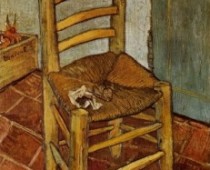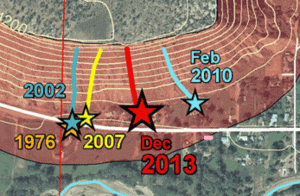The night of the rockfall, those of us within a mile of the ruined house were asked to evacuate, not so much for fear of more fall but because, in the home’s shattered remains, emergency crews could not find the gas shutoff. I changed from mud-smeared barn clothes to appear-in-public clothes, and loaded the dog, three laptops, and my well-honed overnight needs into the truck. After—what is this—my fifth evacuation? I have it down to a science. And at that point, if my house blew up, I couldn’t have cared less. A beautiful day had just gone horrifically bad. The sky had indeed fallen.
I had just driven my workman Brice home to Springdale and returned ten minutes later to find the road beyond my house obliterated by a strange yellow-brown. . . smoke? haze? The morning radio had predicted desert fog, a scoff-worthy anomaly, and yet, what was that? and why had it come up so suddenly and in such a limited space? Fire? I wondered, and drove into the dimness. Inside, the darkness turned red and particulate, eerie and sunless. It was neither an inversion-choked chimney nor smoldering grass, not winter’s condensed breath nor the mark of a dust devil’s passing. It was something I’d seen only once or twice and never from within—pulverized redrock suspended mid-fall—buoyed only by still air’s impassive resistance, afloat on its own surprise.
Confused, I searched for some clue, scanning left and right until I saw, out of the corner of my eye, Ground Zero. I did not stop, did not linger, did not slow. My head snapped forward, eyes wide, and we drove on: my body kicking into mechanical while my brain caught up— “Danger. No chance of survival. Rescuers at risk.” Farther along the road, I parked askew, flipped on my hazards, and flashed my brights at highway-speed cars entering Rockville and the rescuer-obscuring cloud.
Behind me others were stopping at what was once the two-story home of Maureen Morris and Jeff Elsey. In my rearview I watched neighbors jump from home-bound trucks, dash across the highway and up slope toward the crushed home; I admired their bravery—no one could know if more rock would fall, but more I admired their hope—I could not conceive anyone surviving that blow. As 911 phones rang across the county, I dialed Jack Burns, the survivor of our first traumatizing home rockfall, “Sweetie. I need to tell you. There’s been a horrific rockfall. And, if anyone was home…”
As the sheriff’s tan SUV roared past, I reluctantly joined the growing roadside vigil. The home’s second-story lay on the gravel drive like a casually discarded hat; above, the kitchen’s burst-belly revealed a mission-style dining room table still standing, and a comfortable green armchair kicked aside and dust-covered; the home’s foundation still held, anchored as it was in the boulder field of a former rockfall. Between the redesigned, implacable boulderscape and the log home’s swinging timbers echoed the fresh bomb blast, the impossible silence of still-warm disaster.
Those willing combed the debris,peering into cavities, reaching into possibilities, then stood, arrayed around the house on fallen boulders, and stared at us, as silent as the rocks and as unmoving, hollow-eyed and shellshocked. This would not be a rescue.
I disentangled myself from a supporting friendship-knot and, as darkness fell, headed back to my car and home, only two houses distant. I noticed for the first time the view Maureen and Jeff had from their floor-to-ceiling windows—out across unobstructed pastures to the cottonwood-lined Virgin River, up across sage-coated redrock mesas to the towering Canaan Mountain Wilderness and the blue-skied beyond. I also noticed, in Mr. Herschi’s deep grass pasture near the road, the rare, knee-deep virginal snow and its new sprinkled-sugar coating of powdered redrock.
I had been in my barn clothes as dusk and rocks fell and rescuers asked me to leave because that day, December 12, was my first ride since the big snow. Five days before, we’d gotten a rare 18 inches, and I, not owning a snow shovel, had dug my way to the horses with a hay fork. This was the snow that would provide me such a beautiful, memorable afternoon, and set loose the rock that would later kill Maureen and Jeff.
The horses, and especially I, get antsy when pent, and after a week of buried fields but gradually clearing roads, we dared a short ride in brilliant sun. We began with due care on snow-packed ice, but when Mr. Baby saw the untracked orchard field, he broke acanter and I let him. Never had I felt that particular exhilaration! In snow’s deep silence, one can neither hear nor see hooves hit ground so horse and rider simply fly. Had the field gone on forever or had I fallen to earth and cracked my head wide open, I would have been happy ever after.
I drove, that evacuation night, to the local Mormon Church’s annual Christmas Party, a usually lively but very subdued affair. My 30-year-friend Marion asked, “Are you still living in Rockville?” “Yes,” I replied, “I’m still living in Rockville”… unlike others, I thought sadly. Rockville, settled in 1860 when pioneers abandoned the flooded town of Adventure across the Virgin River, probably got its name from difficult plowing, but has unfortunately taken on new meaning. This is not an easy landscape—just as our lives and decisions are not easy. At the candlelight memorial held a few nights later amid fallen rocks and departed souls, friends spoke of how Maureen decided, with great intention and without fear, to live in Rockville, in that very house, because she loved it. She was aware of the risk, calculated the odds, and made her decision. And I honor her choice. More power to you, Maureen!
From now on I’m also choosing to live with intention. Having developed a few less-than-desirable habits, devastatingly effective procrastinations, and functionally slippery ways to side-step things that need to be said, I’m now choosing to be more present.
And I hope the next time I end up with yet another pony-induced black eye, more stitches, a dysfunctional body part, or even kill myself falling from cliff or saddle it’s because I chose to get on the horse again. Stitches are temporary, but a life lived without intention is forever.
Last week, escaping the desert’s firm grip on my soul, I traded loose-hipped canters for a kayak’s unfamiliar hug. Far from shore on an ocean’s winter night, one tip away from a hypothermic death, I found myself immersed in mysterious cronks and snorks—the dreams of herons on their island roost. A paddle length behind me, a curious seal surfaced, revealed in her inky wateriness only by the abrupt snap of opened sinuses followed by a deep, voluminous inhalation. As she and the silence descended again, I paddled on and reveled as phosphorescent bioluminescence swirled from my everybladed stroke, particulate radiance whipped up—then gone—like glowing dust devils—like the infinite galaxies whirling overhead.













